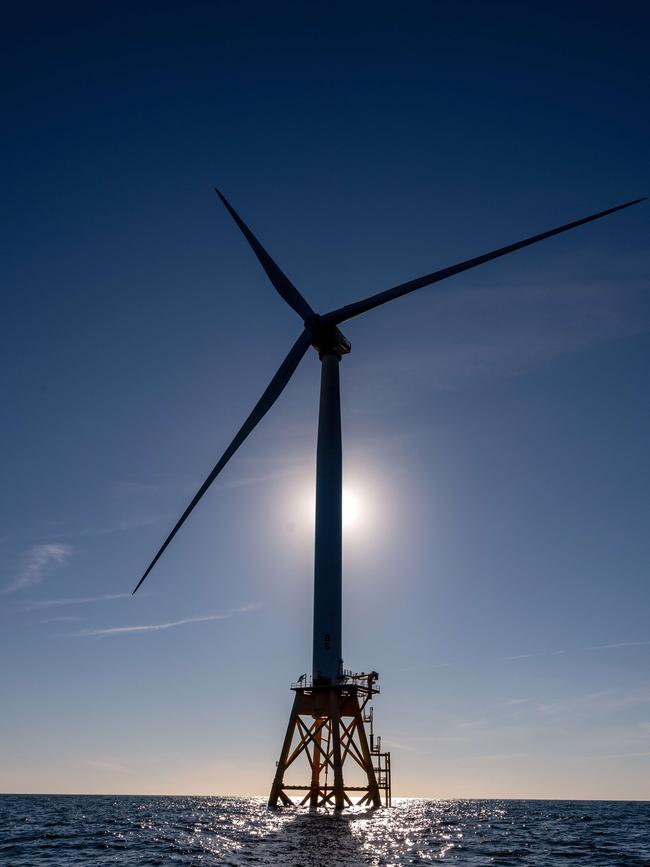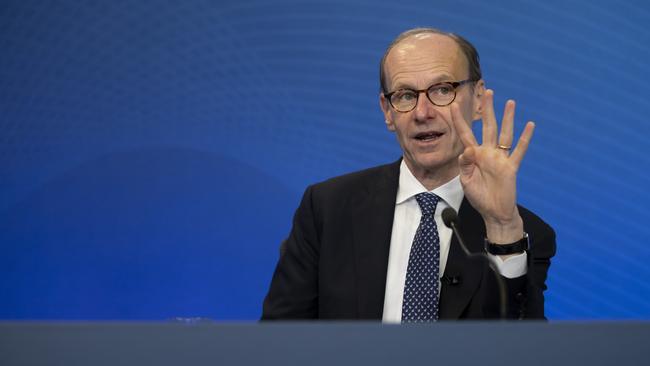Bank profits: Is gravity finally about to catch up with Macquarie
It would be more foolhardy than brave to bet against Macquarie, however at some point the laws of physics apply.
Business
Don't miss out on the headlines from Business. Followed categories will be added to My News.
It would be more foolhardy than brave to bet against Macquarie, however at some point the laws of physics apply and its momentum will stall. This just might be that year.
Where most Wall Street banks have struggled, Shemara Wikramanayake’s homegrown cash machine has signed off on another phenomenal year where it was the big beneficiary of the disruption in Europe’s energy markets. Macquarie had slowly, almost invisibly been building up a stake in gas trading and storage across Europe and North America over many years and the payday finally came.
Most of the credit went to Macquarie’s new multimillion-dollar man. That’s the head of commodities and global markets Nick O’Kane, who last financial year collected a whopping $57.6m. This saw him outshine his boss Wikramanayake, who took home $32.8m in a very good year. That’s also the Macquarie model at work: Make money for shareholders and you too can make serious money.

O’Kane and his unit did just that, with the commodities unit delivering a 54 per cent jump in operating profit to $6bn during the past financial year. Indeed his business that sourced, sold and shipped oil, gas and electricity around the world largely delivered the top-line growth for the investment bank, pulling in some 60 per cent of earnings. By a way of how significant O’Kane’s business has now become to Macquarie, three years ago in a more normal world commodities and markets was retuning flat profits of $1.7bn.
The massive success of one single division over what has been 18 months has now created a new dilemma for the bank that has worked hard since the global financial crisis to eliminate swings in earnings – the over-reliance on a highly-capital intensive business for its earnings.
To put it in context, the commodities lift helped offset a 17 per cent drop in earnings from traditional powerhouse Macquarie Asset Management. In total Macquarie delivered a 10 per cent lift in net profit to $5.2bn.
‘Stable earnings’
Annuity style incomes such as its flagship funds management business tends to outperform in more stable, slowing markets and it only represented a little over 40 per cent of earnings last year. Macquarie would rather it push back toward 50 per cent at least to keep the investment bank on an even risk footing.
Wikramanayake points out Macquarie is now operating in so many different markets — geographically and through different commodities — that earnings are not just built around gas and power but “it could occur in many areas”.
In an interview with The Australian she said the earnings from carbon-based energy commodities also remain consistent with Macquarie’s more public efforts in courting the renewables market.
“We need massive investment in renewables if we’re to address the climate change issue. But we can’t overnight shut off all the sources of conventional energy or transport or agricultural, everything we have,” she said.
“Our view has always been that it has to be an orderly transition. And we are going to need particularly gas as a potential transition fuel as we move from fossil fuels to renewable energy”.

The same forces that have been driving Macquarie to its highs are starting to unwind. Commodity markets have pulled back with Europe working through its energy shortage and bond markets are pricing in a recession in the US, Macquarie’s biggest single market. Even in Australia where Macquarie has been busy stealing mortgage market share from the big four, loans momentum has been slowing in recent months.
Wikramanayake is keeping her trademark caution over the short-term outlook but she says the same forces driving the medium the term strength remain in place. The regional banking crisis unfolding in the US while not directly impacting Macquarie this might cause stresses around the funding of commercial property, small business and infrastructure there. Although that could also be an opportunity for the cashed-up Macquarie to step into.
And while Macquarie has been an acquirer of wealth assets in the US in recent years a bank acquisition isn’t on its agenda. Such a move would be “risky”, Wikramanayake says. “All our capability in banking is here in Australia. This is where our digital banking platform is built and where our regulator is. It’s unlikely we’d buy a bank”.
Longer term, the massive renewables subsidies in place from the US Inflation Reduction Act is delivering opportunities for players like Macquarie in the areas of renewable infrastructure or new forms of energy like hydrogen. It is still investing in people, including hiring more than 2000 in Australia over the past year, mostly in technology.
Over nearly two decades Macquarie has delivered a return on equity on average of 17 per cent each year. Last year it was 28 per cent.
The group as a whole delivered on average a 14 per cent annual return on assets over the long term. Last year it posted 16.9 per cent on this measure. Even Macquarie can’t defy gravity forever.
Sun rises for ANZ
Suncorp bank is ANZ chief Shayne Elliott’s acquisition to lose if he fails to make the case to regulators that competition for loans and deposits has shifted online and not in the bank branch.
The Australian Competition and Consumer Commission is arriving at the final stages of whether to green light ANZ’s planned $4.9bn buyout of Suncorp’s Queensland-focused banking arm, in what could be the last significant regional buyout by a major Australian bank.
However the regulator last month took a downbeat view on the deal, with its preliminary finding raising concerns the move would remove another competitive handbrake on the major banks.

Investors with money on the line have taken a different view about what’s taking place in the banking market. They sliced about $10bn in share value from the big four in the past two days on fears competitive forces are set to undermine profits over the medium term.
Since the end of last year banks have been scrambling to hold on to customers as the wave of fixed mortgage renewals come up. Now there is a scramble for deposits as global money are markets strained, meaning there is a huge demand to secure local funds.
All this has come at a cost, with banks trading profit to chase market share.
National Australia Bank this week got the ball rolling as it warned of a bigger-than-expected squeeze on its profit margins and more pressure to come, slicing almost 7 per cent from its shares.
ANZ too, while delivering a record first half cash earnings of $3.82bn earlier Friday, confirmed its profit margins were set to be squeezed.
ANZ’s Elliott told The Australian competition is “more intense” than it has ever been with rival banks, including offshore players and fintechs chasing the same business. The battle is now online thanks to the hot offer for deposits and banks are racing to sign customers up to instant mortgage approvals. ANZ says its long-awaited fast home loan is in beta testing phase and will go live shortly.
On Friday Macquarie chief executive Shemara Wikramanayake said the focus for growing her retail bank was through online channels. “That’s been the way we’ve competed in terms of growing our home loan portfolio,” Wikramanayake said. Macquarie piled on a staggering 31 per cent in home loan growth in Australia., although that was for the full year. Macquarie also called out momentum slowing in mortgages.
‘Below cost’
Elliott acknowledged that ANZ was writing some new loans below the cost of capital – that is they are acting as a loss leader on the hope it will bring in other business such as deposits.
Apart from a few blips, around the global financial crisis and through Covid-19, the ANZ boss believes it's a three decade trend in Australian banking that margins have been declining.
“If you step back and think about what is the long term driver here, that driver is competition,” Elliott said in an interview.
“At the end of the day, how would you know customers are getting a better deal? Well, the margin between what we pay for deposits and what we lend money out would be shrinking.
“And that is the case”.
This means the economy is getting a better outcome and that “forces banks like us to be more innovative, to be more productive, and to fight harder to stay in the game”.

After losing out on mortgage market share through the early days of the Covid pandemic,
Banks are literally throwing cash at good borrowers, with up to $5000 on offer to sign up to new loans. At the same time many lenders, including ANZ, are offering deep discounts under the table from advertised headline rates.
The ANZ interim cash profit was up 12 per cent over the same time last year while its interim dividend of 81c was up 7c. The bank is yet to see a meaningful lift in bad debts or stressed loans with individual provision charges falling. However it set aside more funds as the bank prepares for a slowing Australian economy in the second half of this year.
ANZ has clawed back momentum in loans adding $10bn during the half, helped by a lift in business from mortgage brokers.
Combined with Suncorp, ANZ’s national mortgage market share will see it nudge slightly ahead of National Australia Bank’s 15 per cent but remain well behind CBA’s and Westpac’s 21 per cent share.
The ACCC is set to make its final determination on Suncorp in July.
johnstone@theaustralian.com.au
Originally published as Bank profits: Is gravity finally about to catch up with Macquarie





